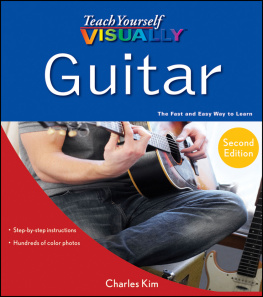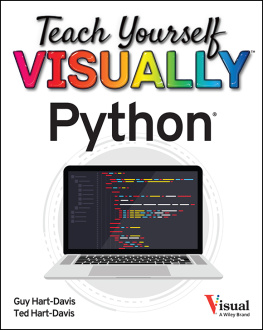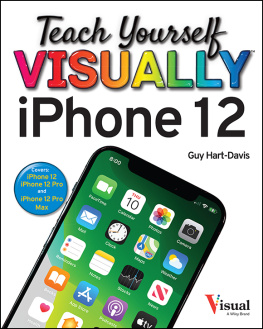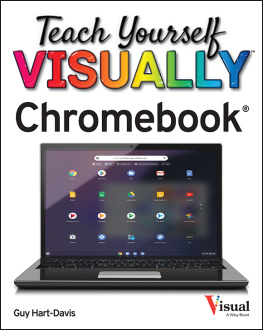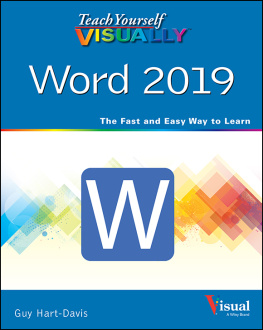Charles Kim - Teach Yourself VISUALLY Guitar
Here you can read online Charles Kim - Teach Yourself VISUALLY Guitar full text of the book (entire story) in english for free. Download pdf and epub, get meaning, cover and reviews about this ebook. year: 2012, publisher: Wiley, genre: Children. Description of the work, (preface) as well as reviews are available. Best literature library LitArk.com created for fans of good reading and offers a wide selection of genres:
Romance novel
Science fiction
Adventure
Detective
Science
History
Home and family
Prose
Art
Politics
Computer
Non-fiction
Religion
Business
Children
Humor
Choose a favorite category and find really read worthwhile books. Enjoy immersion in the world of imagination, feel the emotions of the characters or learn something new for yourself, make an fascinating discovery.
- Book:Teach Yourself VISUALLY Guitar
- Author:
- Publisher:Wiley
- Genre:
- Year:2012
- Rating:5 / 5
- Favourites:Add to favourites
- Your mark:
- 100
- 1
- 2
- 3
- 4
- 5
Teach Yourself VISUALLY Guitar: summary, description and annotation
We offer to read an annotation, description, summary or preface (depends on what the author of the book "Teach Yourself VISUALLY Guitar" wrote himself). If you haven't found the necessary information about the book — write in the comments, we will try to find it.
Teach Yourself VISUALLY Guitar — read online for free the complete book (whole text) full work
Below is the text of the book, divided by pages. System saving the place of the last page read, allows you to conveniently read the book "Teach Yourself VISUALLY Guitar" online for free, without having to search again every time where you left off. Put a bookmark, and you can go to the page where you finished reading at any time.
Font size:
Interval:
Bookmark:

 Guitar Second Edition by Charles Kim
Guitar Second Edition by Charles Kim  Teach Yourself VISUALLY Guitar, 2nd Edition Copyright 2012 by John Wiley & Sons, Inc., Hoboken, New Jersey. All rights reserved. Published by John Wiley & Sons, Inc., Hoboken, New Jersey Published simultaneously in Canada No part of this publication may be reproduced, stored in a retrieval system or transmitted in any form or by any means, electronic, mechanical, photocopying, recording, scanning or otherwise, except as permitted under Sections 107 or 108 of the 1976 United States Copyright Act, without either the prior written permission of the Publisher, or authorization through payment of the appropriate per-copy fee to the Copyright Clearance Center, 222 Rosewood Drive, Danvers, MA 01923, (978) 750-8400, fax (978) 646-8600, or on the web at www.copyright.com. Requests to the Publisher for permission should be addressed to the Permissions Department, John Wiley & Sons, Inc., 111 River Street, Hoboken, NJ 07030, (201) 748-6011, fax (201) 748-6008, or online at www.wiley.com/go/permissions. Wiley, the Wiley logo, Teach Yourself VISUALLY, and related trademarks are trademarks or registered trademarks of John Wiley & Sons, Inc., and/or its affiliates. All other trademarks are the property of their respective owners.
Teach Yourself VISUALLY Guitar, 2nd Edition Copyright 2012 by John Wiley & Sons, Inc., Hoboken, New Jersey. All rights reserved. Published by John Wiley & Sons, Inc., Hoboken, New Jersey Published simultaneously in Canada No part of this publication may be reproduced, stored in a retrieval system or transmitted in any form or by any means, electronic, mechanical, photocopying, recording, scanning or otherwise, except as permitted under Sections 107 or 108 of the 1976 United States Copyright Act, without either the prior written permission of the Publisher, or authorization through payment of the appropriate per-copy fee to the Copyright Clearance Center, 222 Rosewood Drive, Danvers, MA 01923, (978) 750-8400, fax (978) 646-8600, or on the web at www.copyright.com. Requests to the Publisher for permission should be addressed to the Permissions Department, John Wiley & Sons, Inc., 111 River Street, Hoboken, NJ 07030, (201) 748-6011, fax (201) 748-6008, or online at www.wiley.com/go/permissions. Wiley, the Wiley logo, Teach Yourself VISUALLY, and related trademarks are trademarks or registered trademarks of John Wiley & Sons, Inc., and/or its affiliates. All other trademarks are the property of their respective owners. John Wiley & Sons, Inc., is not associated with any product or vendor mentioned in this book. The publisher and the author make no representations or warranties with respect to the accuracy or completeness of the contents of this work and specifically disclaim all warranties, including without limitation warranties of fitness for a particular purpose. No warranty may be created or extended by sales or promotional materials. The advice and strategies contained herein may not be suitable for every situation. This work is sold with the understanding that the publisher is not engaged in rendering legal, accounting, or other professional services. If professional assistance is required, the services of a competent professional person should be sought.
Neither the publisher nor the author shall be liable for damages arising here from. The fact that an organization or website is referred to in this work as a citation and/or a potential source of further information does not mean that the author or the publisher endorses the information the organization or website may provide or recommendations it may make. Further, readers should be aware that websites listed in this work may have changed or disappeared between when this work was written and when it is read. For general information on our other products and services or to obtain technical support, please contact our Customer Care Department within the U.S. at (877) 762-2974, outside the U.S. at (317) 572-3993 or fax (317) 572-4002.
Wiley publishes its books in a variety of electronic formats and by print-on-demand. Some material included with standard print versions of this book may not be included in e-books or in print-on-demand. If this book refers to media such as a CD or DVD that was not included in the version you purchased, you may download this material at booksupport.wiley.com. For more information about Wiley products, visit www.wiley.com. Library of Congress Control Number: 2011943434 ISBN: 978-1-118-13334-7 (pbk) ISBN: 978-1-118-20627-0 (ebk) ISBN: 978-1-118-20628-7 (ebk) ISBN: 978-1-118-21713-9 (ebk) Printed in the United States of America 10 9 8 7 6 5 4 3 2 1 Book production by John Wiley & Sons, Inc., Composition Services Credits Acquisitions Editor Pam Mourouzis Project Editor Suzanne Snyder Technical Editor Geoff Dolce Editorial Manager Christina Stambaugh Vice President and Publisher Cindy Kitchel Vice President and Executive Publisher Kathy Nebenhaus Interior Design Kathie Rickard
Elizabeth Brooks Photography Matt Bowen Graphics and Production Specialists Joyce Haughey
Sennett Vaughan Johnson
Brent Savage About the Author Charles Kim (Chicago, IL) plays guitar, electric and upright bass, pedal steel, banjo, violin, alto saxophone, piano, keyboards, and drums. He teaches guitar, bass, songwriting, recording, and music theory at Chicagos renowned Old Town School of Folk Music.
A multifaceted musician, producer, and composer featured on numerous albums, Kim is also a composer and sound designer for film, TV, dance, and theatre companies. His scores have been commissioned and featured by the Royal Academy of Art, Showtime, and the History Channel.  Acknowledgments I would like to sincerely thank my editors Pam Mourouzis and Suzanne Snyder for giving me the opportunity to write this book. Audrey Cho was kind enough to take my photo. Id also like to thank my family, friends, bandmates, and the Old Town School of Folk Music, who supported me to grow as a musician. This book is dedicated to my mother, Hai Ja Kim, who was my first music teacher.
Acknowledgments I would like to sincerely thank my editors Pam Mourouzis and Suzanne Snyder for giving me the opportunity to write this book. Audrey Cho was kind enough to take my photo. Id also like to thank my family, friends, bandmates, and the Old Town School of Folk Music, who supported me to grow as a musician. This book is dedicated to my mother, Hai Ja Kim, who was my first music teacher.
Special Thanks To the following companies for granting us permission to show photos of their equipment: Renos Music Sweetwater
 Start Playing Today Violin and trumpet students have to practice diligently for years to play a major scale with a warm tone in tune.
Start Playing Today Violin and trumpet students have to practice diligently for years to play a major scale with a warm tone in tune. While the guitar will eventually make its intricacies known to you, you can learn the first three chords (see Chapter 6) and a simple strumming pattern (see Chapter 9) on your first day. The frets, which divide the string length, do the job of keeping you in tune, and youll play simple rhythms until you develop more coordination. Although youll eventually want to reach higher levels of proficiency, you can start creating music right away! Set Goals for Yourself The trick to teaching yourself anything is to practice on a steady schedule and to set realistic goals. Give yourself time to learn, and dont get discouraged if things dont come to you immediately. People often become their own worst enemies when learning a musical instrument because they set unrealistic goals. Remember that mastering an instrument is a learning process that is both mental and physical.
You understand what you have to do, but training your hands takes time. Allow your body to develop muscle strength and memory, which are slower to develop in an adult. You will eventually develop those skills, so dont lose patience! Practice the Right Way Develop a reasonable but steady practice regimen. Try to practice every day, if only for 15 or 20 minutes. If you cant practice every day, try not to put your guitar away for several days in a row. Make sure youre playing at least every other day.
Leave the guitar next to the TV or somewhere else where youll see it often, and let your hands get used to the instrument in your spare time. Starting and stopping your guitar playing will only make the process more discouraging. You will probably progress more quickly than you realize or give yourself credit for. Be prepared to work through the rough spots. Your efforts eventually will be rewarded! Keep the learning experience fun by playing songs you love. Doing so will take the work element out of practicing, and youll master the skills you need before you know it! Continue Your Guitar Education Now that youve started your musical journey with the guitar, youll want to find ways to pursue your playing.
Font size:
Interval:
Bookmark:
Similar books «Teach Yourself VISUALLY Guitar»
Look at similar books to Teach Yourself VISUALLY Guitar. We have selected literature similar in name and meaning in the hope of providing readers with more options to find new, interesting, not yet read works.
Discussion, reviews of the book Teach Yourself VISUALLY Guitar and just readers' own opinions. Leave your comments, write what you think about the work, its meaning or the main characters. Specify what exactly you liked and what you didn't like, and why you think so.

